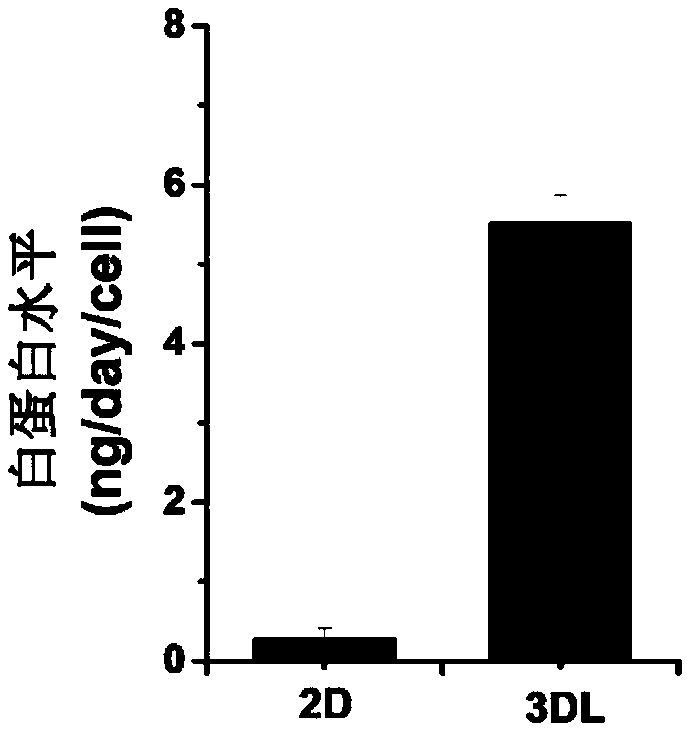Micro hepatic tissue culture model and construction method and application thereof
A technology of liver tissue culture and construction method, which is applied in the field of three-dimensional micro-liver tissue culture model and its construction for the safety evaluation of hepatotoxic drugs. Achieve broad application prospects, improve sensitivity, and high aggregation into balls
- Summary
- Abstract
- Description
- Claims
- Application Information
AI Technical Summary
Problems solved by technology
Method used
Image
Examples
Embodiment 1
[0044] Embodiment 1, obtaining liver biomatrix scaffold powder (LBS powder)
[0045] The method for obtaining the liver biomatrix scaffold (LBS) refers to US008802081B2. Specific experiments may include the following operations:
[0046] 1). First, male SD rats (180-220g) were anesthetized by intraperitoneal injection of ketamine-xylazine, then the abdominal cavity was cut open, and the portal vein of the liver was isolated, and the portal vein was inserted with a 22-gauge catheter (383407, BD, USA) to provide perfusion Entrance.
[0047] 2). Perfuse with PBS (phosphate buffered saline) for 15 minutes to remove blood from the liver.
[0048] 3). Remove plasma and nuclear membrane with 21% sodium deoxycholate (Fisher, Pittsburgh, PA, USA) solution containing 36U / L phospholipase A, and perfuse for about 30 minutes to 1 hour or until the liver tissue becomes close to transparent.
[0049] 4). Perfuse with 3.4M NaCl buffer for 30 minutes, flush the liver with PBS for 15 minute...
Embodiment 2
[0059] Embodiment 2, use HepaRG cell to construct micro-liver tissue model
[0060]In this example, LBS powder and HepaRG cells were used to construct a micro-liver tissue model. HepaRG cells are cell lines isolated from non-tumor tissues in liver cancer patients with chronic hepatitis virus infection. They have the characteristics of hepatic progenitor cells and can express most of the functions of human hepatocytes, including the main CYP enzymes involved in drug metabolism. It can be used in the research of diseases related to liver function and drug metabolism.
[0061] The construction process of the micro-liver tissue model is as follows:
[0062] 1) HepaRG cells (derived from ATCC) in two-dimensional culture (plane culture) in the logarithmic growth phase were digested with 0.25% (0.05-1%) (V / V) trypsin for 1min (0.5-2min average) Yes), stop the digestion with William's E medium (purchased from Gibco) containing 10% (8-15%) (V / V) fetal bovine serum (purchased from Gib...
Embodiment 3
[0067] Embodiment 3, use HepG2 and HUVEC cell to construct microliver tissue model
[0068] In this example, HepG2 and HUVEC cells were used to construct a micro-liver tissue model based on LBS powder.
[0069] HepG2 cell is a human liver cancer cell line, which is derived from human liver cancer tissue. It is the most commonly used cell line for the study of drug metabolizing enzymes, because it has the basic functions of human liver cells such as the expression of albumin and urea, and has the I, Phase II drug-metabolizing enzyme, which can be infinitely expanded in vitro, easy to operate and obtain, and can be used for research on liver function, preliminary drug screening, and liver diseases related to liver cell metabolism; HUVEC cells are human umbilical vein endothelial cells, which have the characteristics of stem cells Potential, in vitro culture can form a vessel-like lumen structure, which can be used in the study of reconstruction of blood vessels in tissue enginee...
PUM
 Login to View More
Login to View More Abstract
Description
Claims
Application Information
 Login to View More
Login to View More - R&D
- Intellectual Property
- Life Sciences
- Materials
- Tech Scout
- Unparalleled Data Quality
- Higher Quality Content
- 60% Fewer Hallucinations
Browse by: Latest US Patents, China's latest patents, Technical Efficacy Thesaurus, Application Domain, Technology Topic, Popular Technical Reports.
© 2025 PatSnap. All rights reserved.Legal|Privacy policy|Modern Slavery Act Transparency Statement|Sitemap|About US| Contact US: help@patsnap.com



